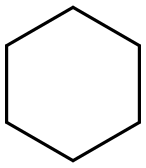Methylcyclohexane , Waterless grade, ≥99% , 108-87-2
Synonym(s):
Hexahydrotoluene;Methylcyclohexane in dimethyl sulfoxide;Methylcyclohexane solution
CAS NO.:108-87-2
Empirical Formula: C7H14
Molecular Weight: 98.19
MDL number: MFCD00001497
EINECS: 203-624-3
PRODUCT Properties
| Melting point: | -126 °C (lit.) |
| Boiling point: | 101 °C (lit.) |
| Density | 0.77 g/mL at 25 °C (lit.) |
| vapor density | 3.4 (vs air) |
| vapor pressure | 37 mm Hg ( 20 °C) |
| refractive index | n |
| Flash point: | 25 °F |
| storage temp. | Store below +30°C. |
| solubility | Miscible with acetone, benzene, ether, carbon tetrachloride, ethanol, insoluble in water. |
| form | Liquid |
| color | Colorless |
| Odor | Faint, petroleum-like |
| explosive limit | 1.1-6.7%(V) |
| Odor Threshold | 0.15ppm |
| Water Solubility | 0.1 g/L (20 ºC) |
| λmax | λ: 207 nm Amax: 1.00 λ: 221 nm Amax: 0.40 λ: 232 nm Amax: 0.15 λ: 260 nm Amax: 0.05 λ: 300-400 nm Amax: 0.01 |
| Merck | 14,6047 |
| BRN | 505972 |
| Henry's Law Constant | 0.0678 at 25.0 °C (Ramachandran et al., 1996) |
| Exposure limits | NIOSH REL: TWA 400 ppm (1,600 mg/m3), IDLH 1,200 ppm; OSHA PEL:
TWA 500 ppm (2,000 mg/m3); ACGIH TLV: TWA 400 ppm (adopted). |
| Dielectric constant | 2.1(25℃) |
| Stability: | Stable. Very flammable. Incompatible with strong oxidizing agents. |
| LogP | 3.88 |
| CAS DataBase Reference | 108-87-2(CAS DataBase Reference) |
| NIST Chemistry Reference | Cyclohexane, methyl-(108-87-2) |
| EPA Substance Registry System | Methylcyclohexane (108-87-2) |
Description and Uses
Methylcyclohexane, an alkene, is a colorless liquid with a faint benzene-like odor. The odor thre-shold is 630 ppm (this is above the OEL). Molecularweight = 98.21; Specific gravity (H2O:1)= 0.77; Boilingpoint = 101℃; Freezing/Melting point= - 127℃; Vaporpressure= 37 mmHg at 20℃; Flash point= - 3.9℃ (cc),- 5.9℃ (oc); Autoignition temperature = 258℃. Explosivelimits: LEL= 1.2%; UEL = 6.7%. Hazard Identification(based on NFPA-704 M Rating System): Health 2,Flammability 3, Reactivity 0. Insoluble in water.
Methylcyclohexane is used as a solvent and reagent in organic synthesis and polymer chemistry. It is a component of jet fuel and also used as correction fluid in certain consumer products. It acts as a starting material for toluene synthesis
Safety
| Symbol(GHS) |     GHS02,GHS07,GHS08,GHS09 |
| Signal word | Danger |
| Hazard statements | H225-H304-H315-H336-H410 |
| Precautionary statements | P210-P233-P273-P301+P310-P303+P361+P353-P331 |
| Hazard Codes | F,Xn,N |
| Risk Statements | 11-38-51/53-65-67 |
| Safety Statements | 9-16-33-61-62 |
| RIDADR | UN 2296 3/PG 2 |
| OEB | A |
| OEL | TWA: 400 ppm (1600 mg/m3) |
| WGK Germany | 2 |
| RTECS | GV6125000 |
| F | 3-10 |
| Autoignition Temperature | 545 °F |
| TSCA | Yes |
| HS Code | 2902 19 00 |
| HazardClass | 3 |
| PackingGroup | II |
| Hazardous Substances Data | 108-87-2(Hazardous Substances Data) |
| Toxicity | Acute oral LD50 for mice 2,250 mg/kg (quoted, RTECS, 1985). |
| IDLA | 1,200 ppm [10% LEL] |


